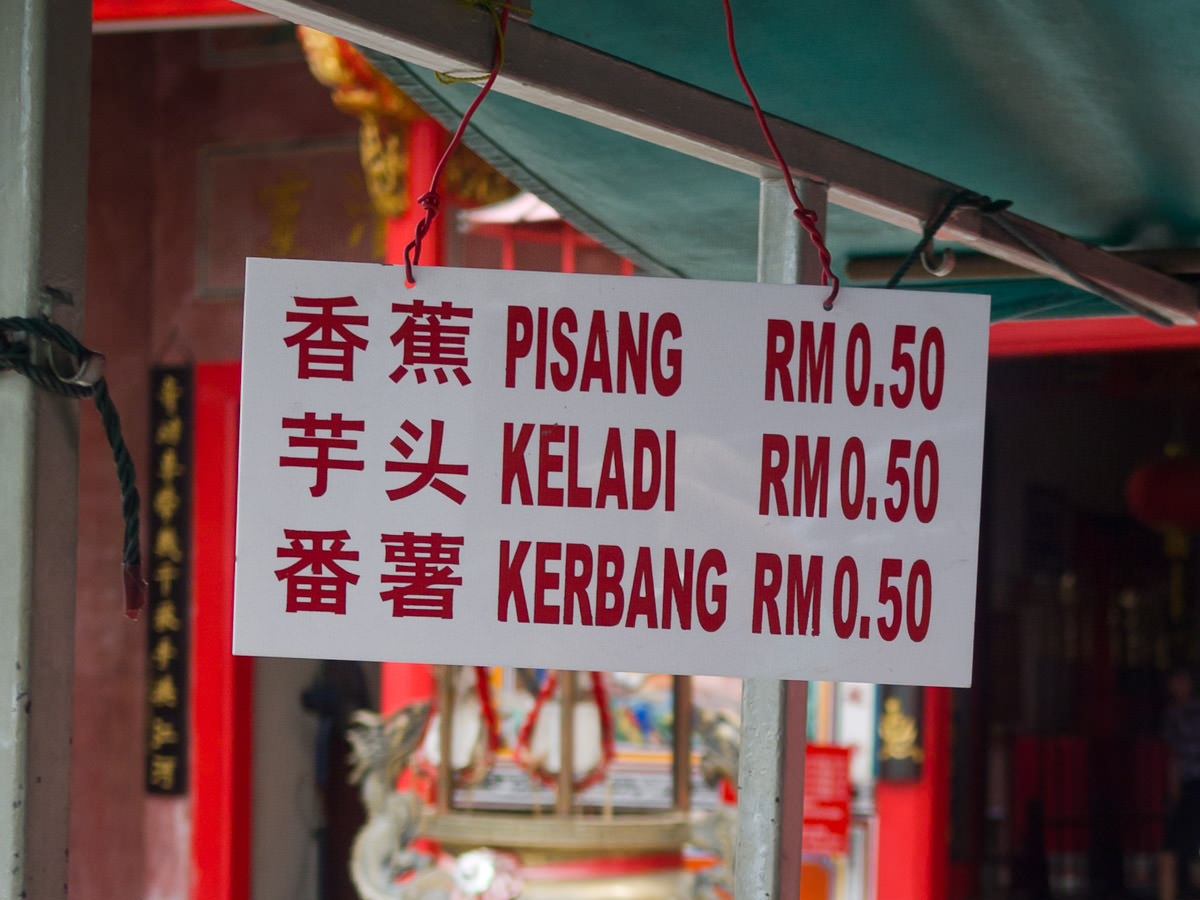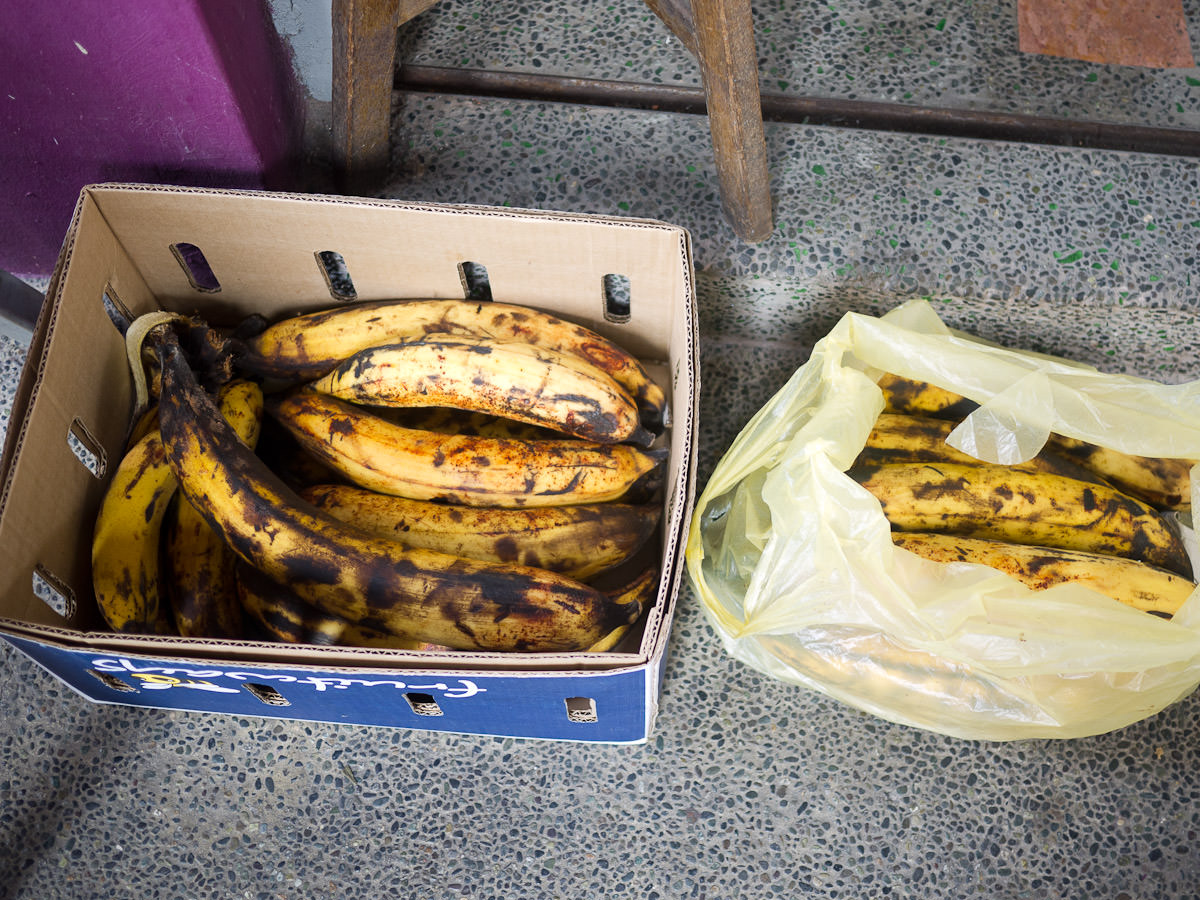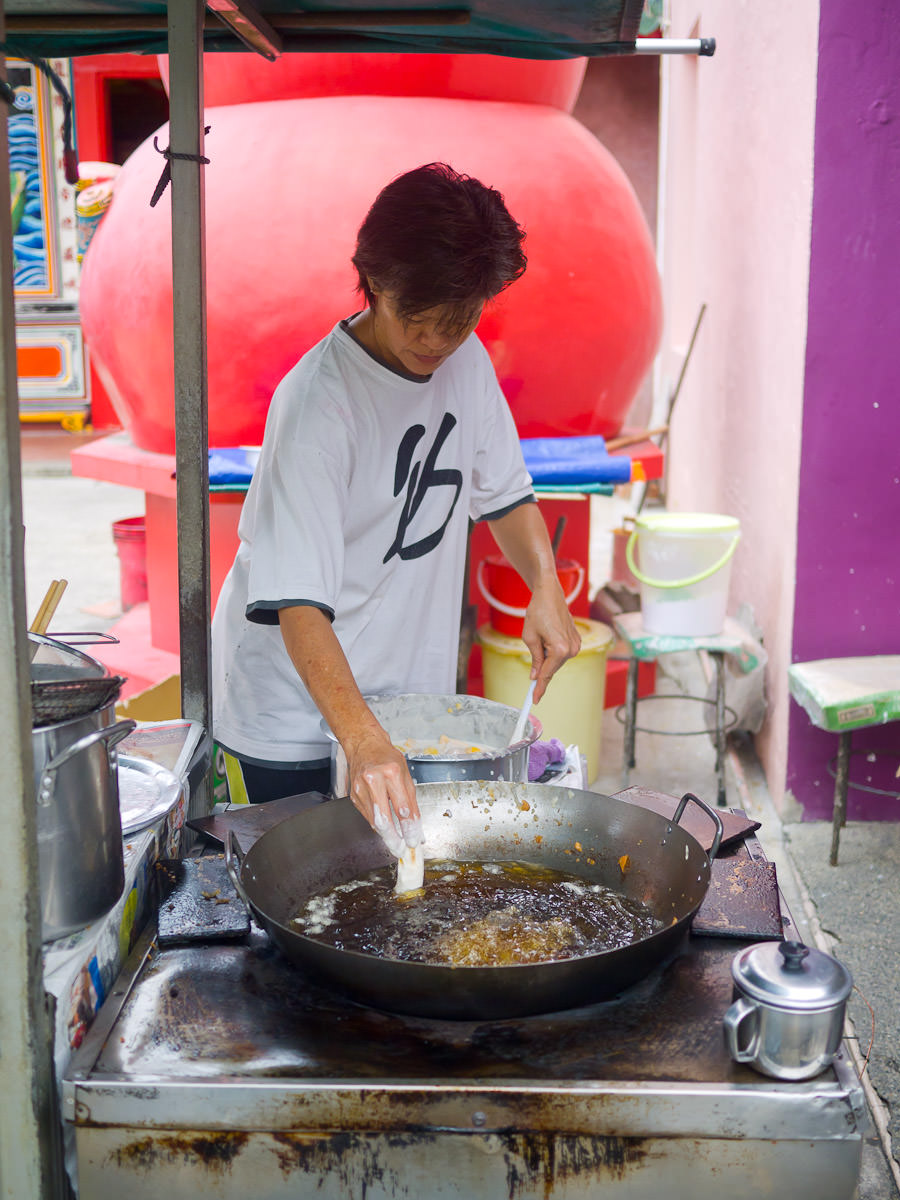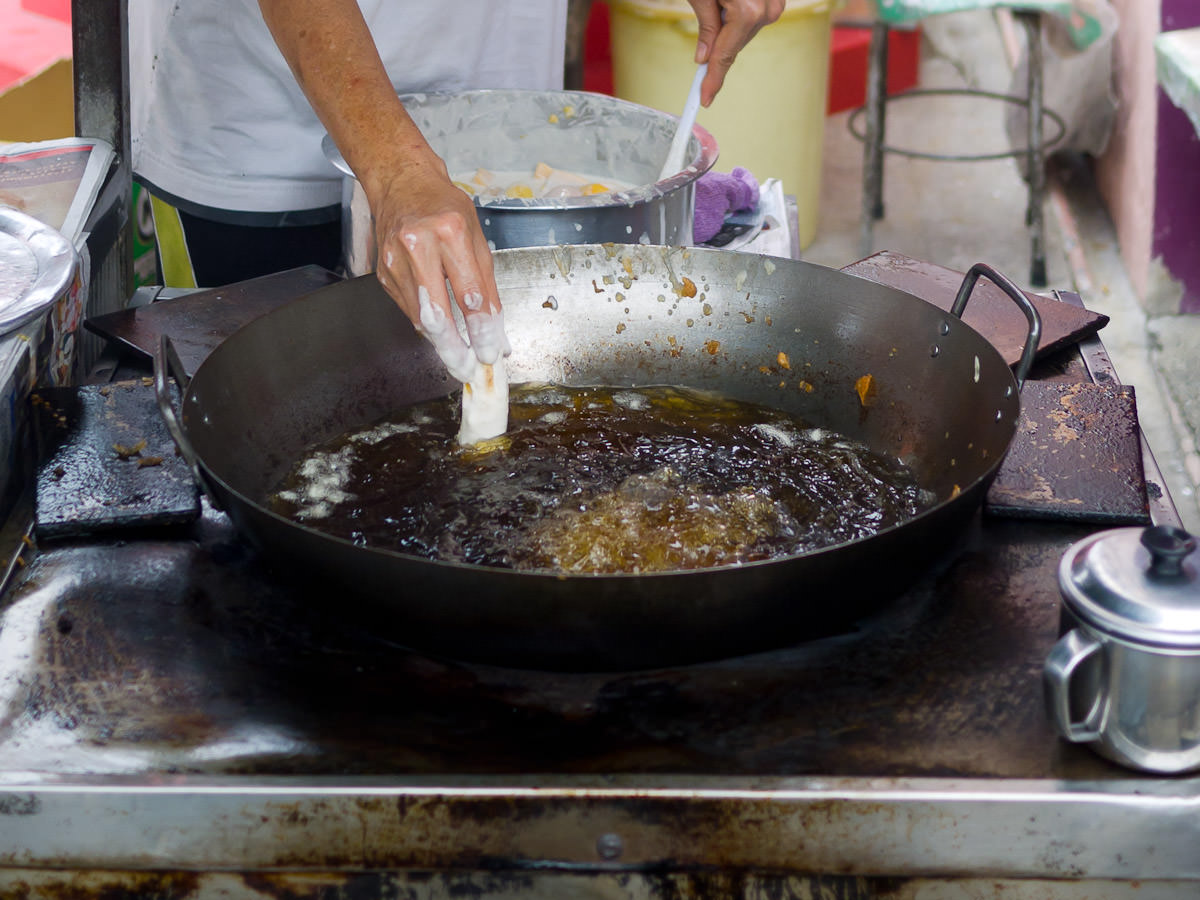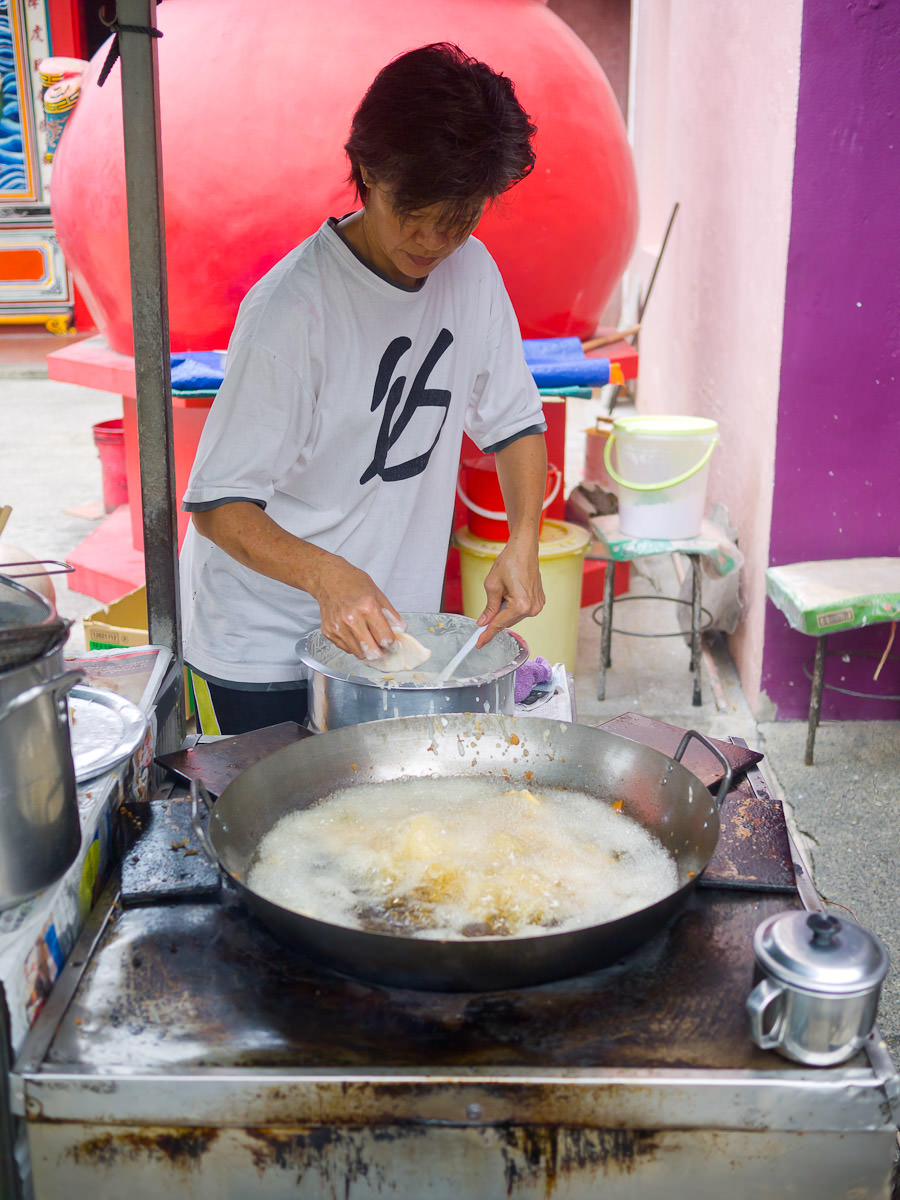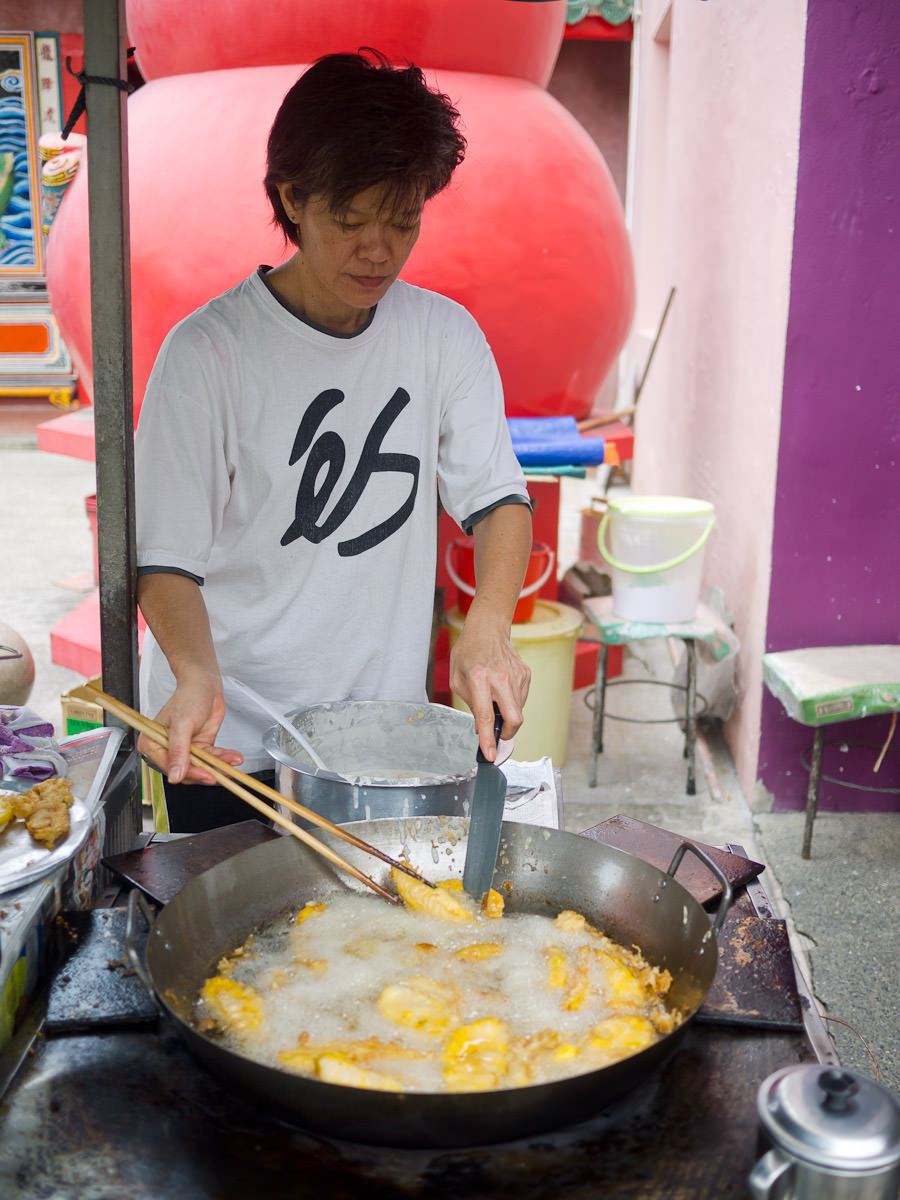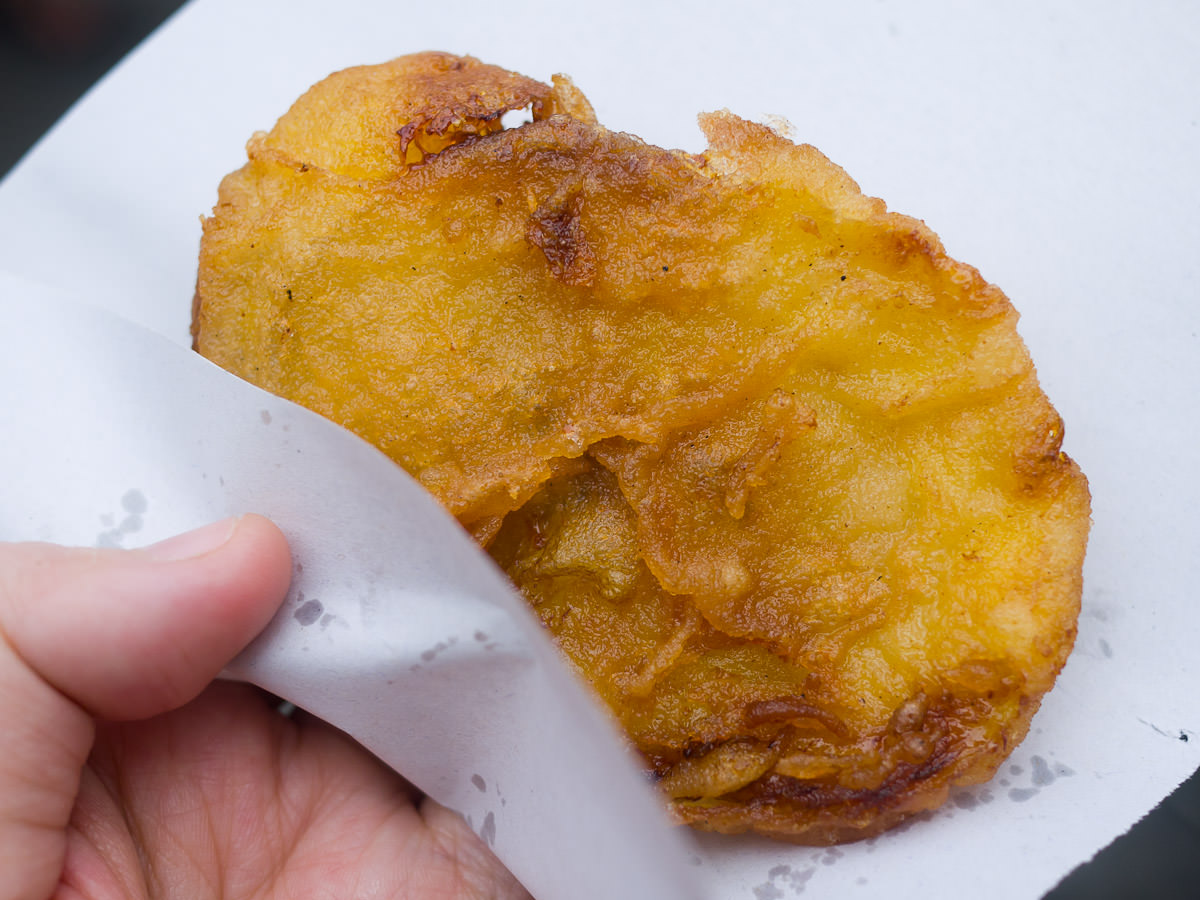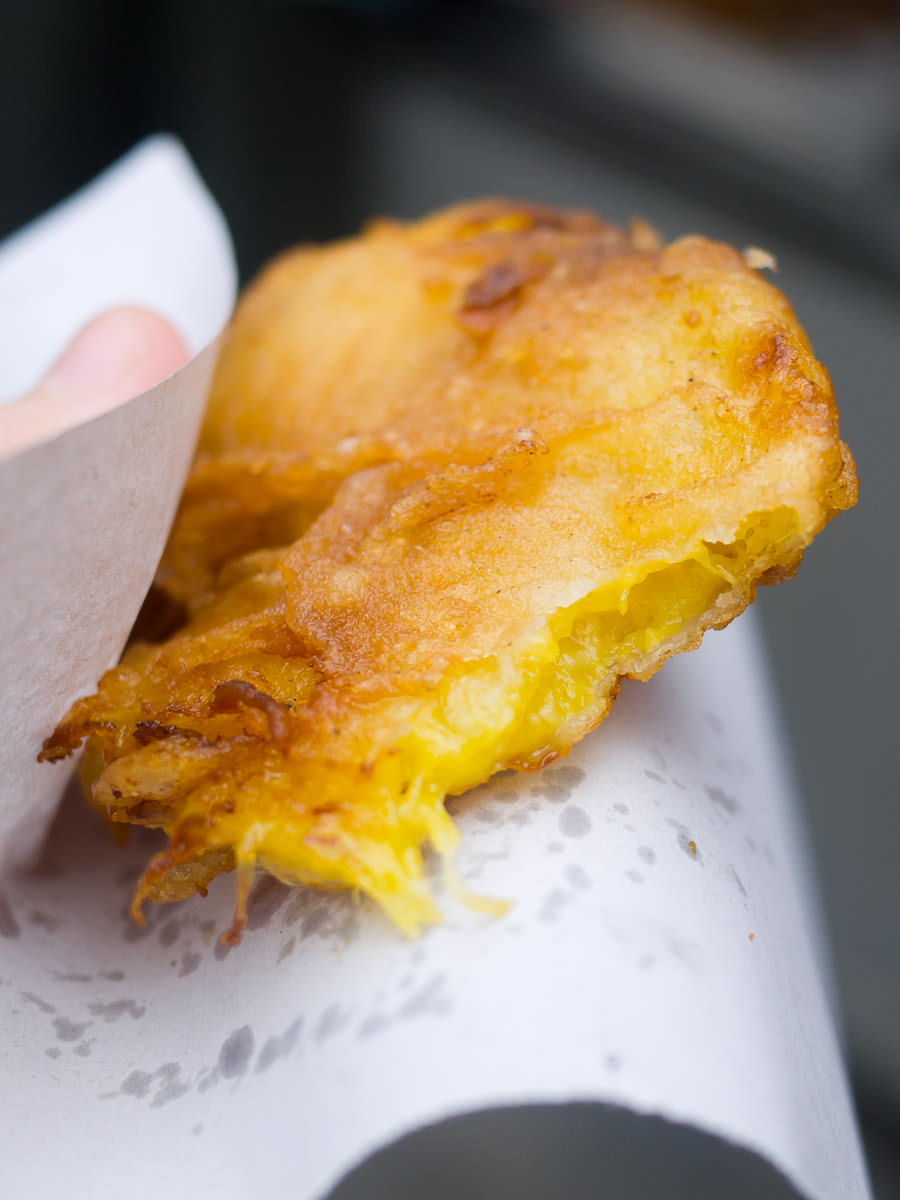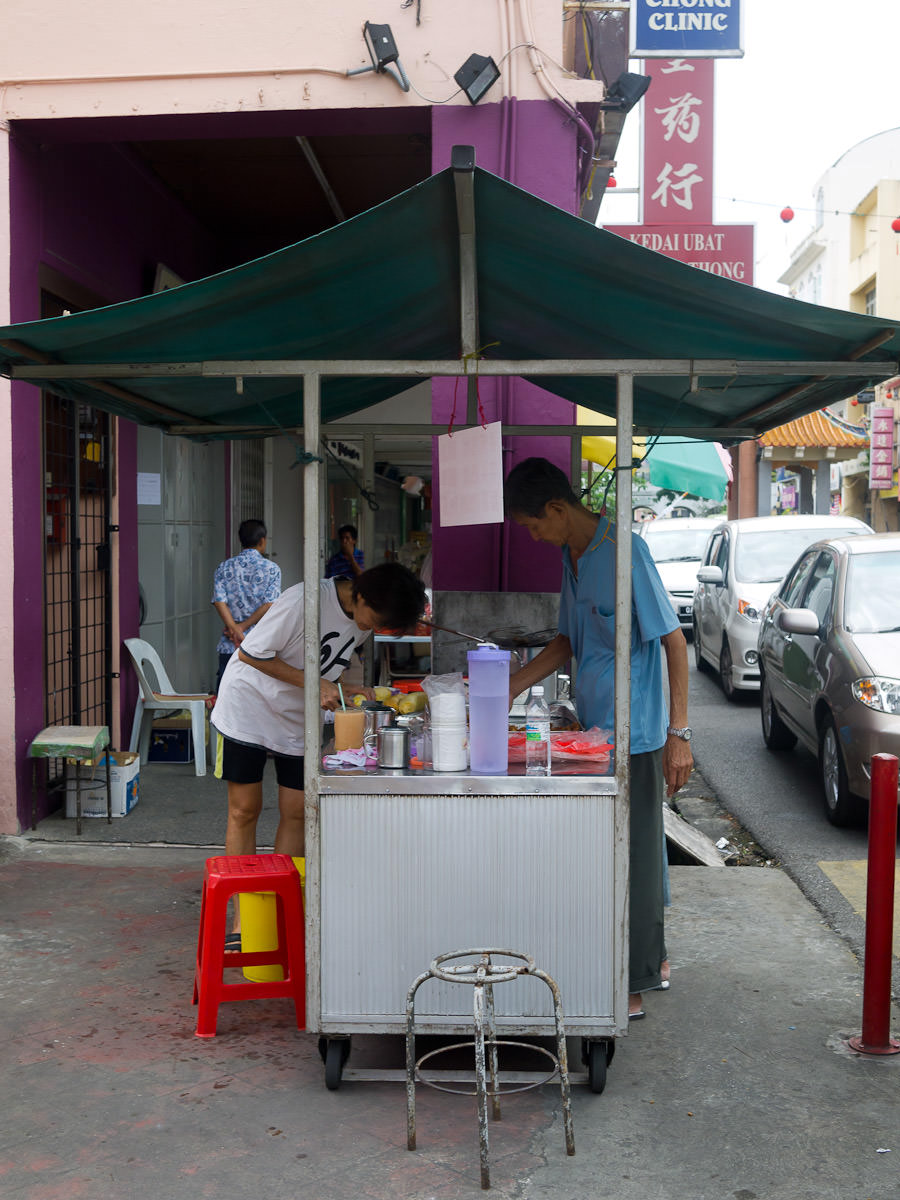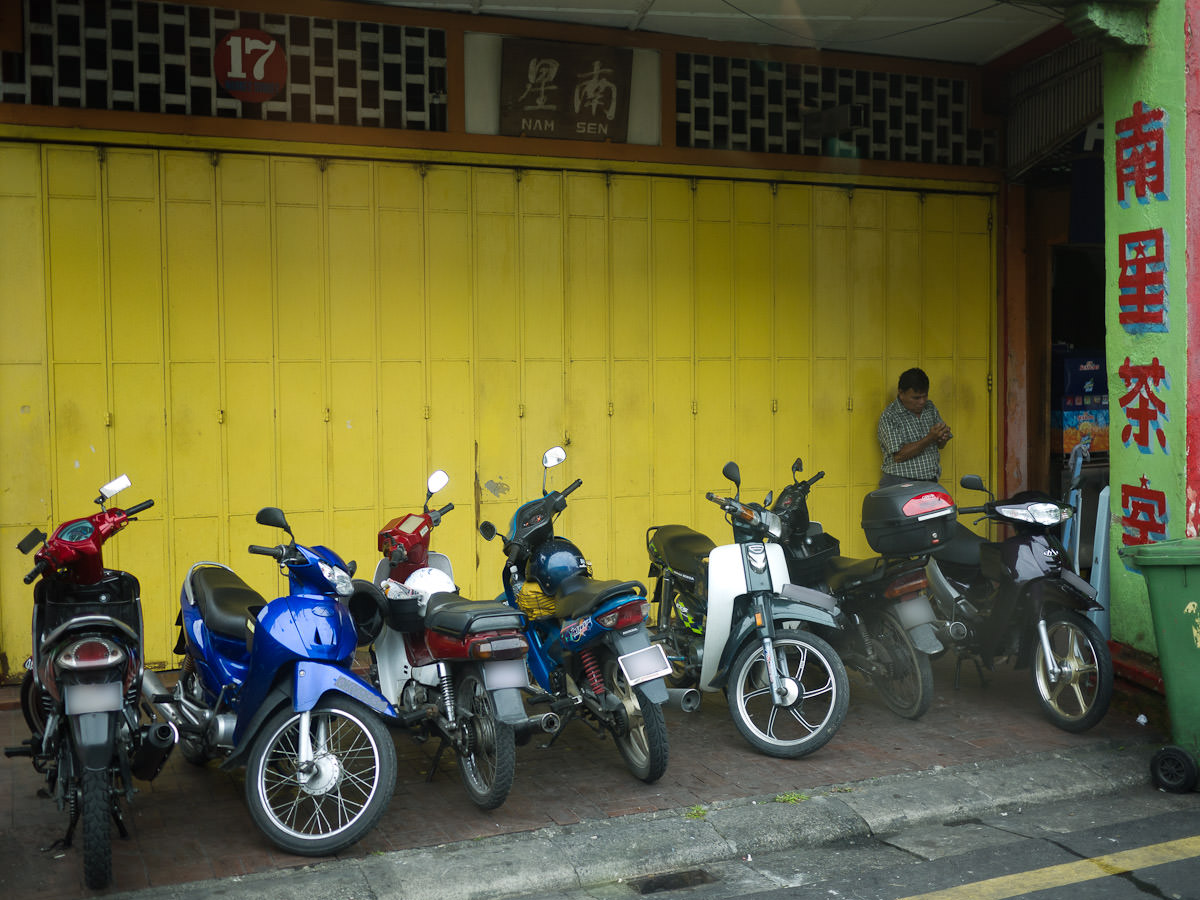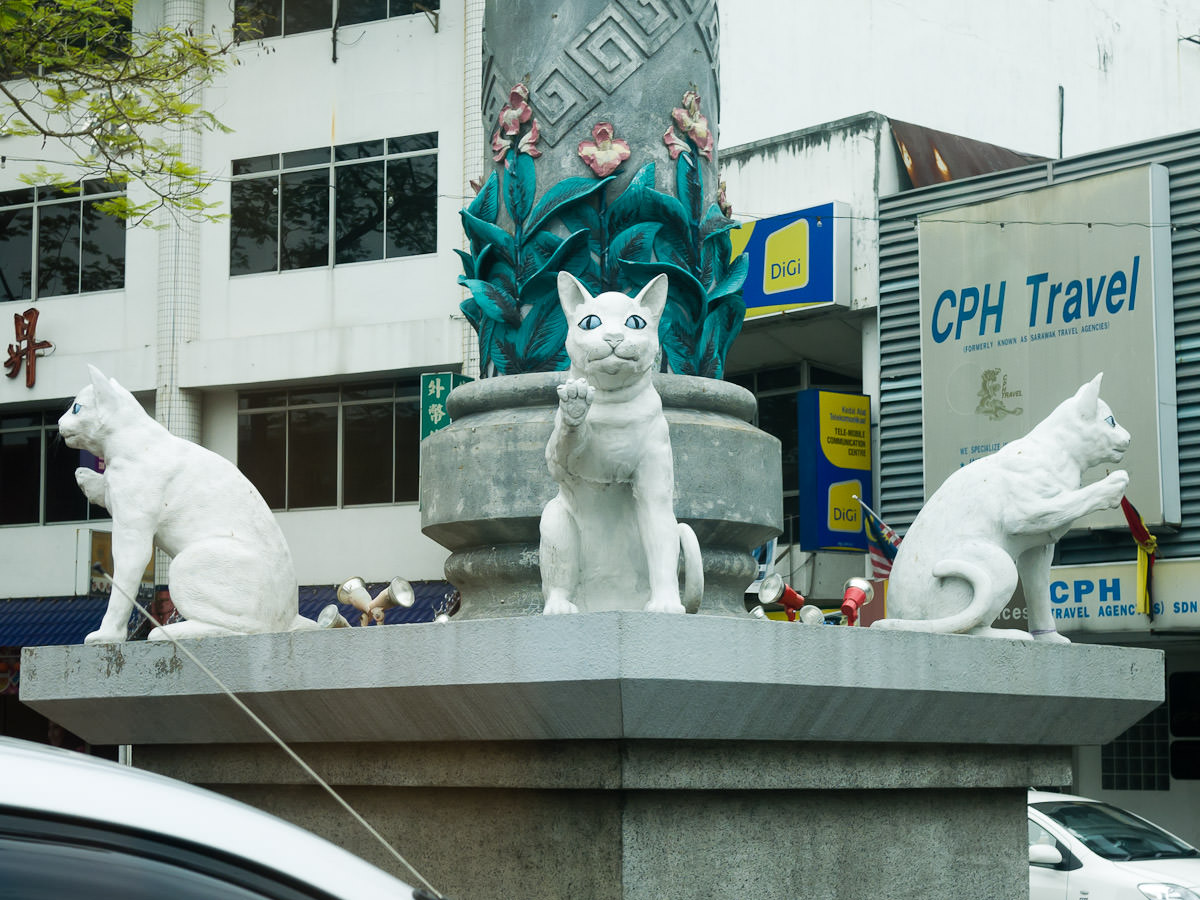Pisang goreng (fried banana) stall on Carpenter Street, Kuching
After visiting Kuching’s famous ABC haven, it’s time to visit Kuching’s most famous pisang goreng (fried banana) stall.
We are told this family-run pisang goreng stall has been around for over 50 years. It has no name and can be found roadside on busy Carpenter Street outside a Chinese temple.
As well as fried bananas, they also sell fried yam and sweet potato fritters. Breadfruit fritters are a seasonal special. The fried banana fritters are the most popular item by far.
On duty today, it’s uncle and niece. Uncle’s not the smiley sort but he doesn’t mind us taking photos to our hearts’ content. He sips from a glass mug of iced tea and brandishes a pair of tongs which he uses to arrange the fritters in rows on a metal tray.
The best bananas for pisang goreng are the larger bananas that hold their shape when ripe – either pisang raja (“banana king” in Malay) or pisang tanduk (“banana horn” in Malay). I’m pretty sure these are pisang raja. You’ll see more bananas in my next Kuching post.
The enormous bananas are peeled, sliced, coated in a special batter and then gently dropped into a wok filled with rolling hot oil.
I can feel the heat as I point my camera at the frying action. Spitting hot oil (and flame grill barbecues) are dangerous but exciting territory for the avid food photographer – I’m pleased to assure you that no food bloggers were injured to bring you this post. :D
The oil bubbles furiously as more bananas are added.
The banana fryer’s tools of choice: super-long chopsticks (note the scorched tips) and a sharp knife to separate fritters that have stuck together. The fritters bob up in the oil as they turn golden-brown. I cannot wait to taste one!
This is tasty, simple, honest street food: a freshly deep-fried hot banana fritter in greaseproof paper, golden-brown and crispy on the outside, no cutlery required. Wipe your fingers on the greaseproof paper when you’re done. Or have another fritter.
I know the banana inside will be molten hot but I burn my tongue on my first bite. The banana is so yellow, sweet and soft. I crunch happily on the crispy batter drippings.
Apologies to Australian banana growers – while I love Australian bananas and eat them all the time, Malaysian bananas taste sweeter than any banana I’ve eaten in Australia. When I’m home in Perth I crave the plump little sweet Malaysian bananas known as “pisang emas” (“emas” means gold” in Malay). As a child I would eat so many of them my grandmother would warn me I’d get the runs.
If you visit Kuching, it’s worth looking out for this pisang goreng stall, especially if you like bananas and appreciate a well fried fritter. When I’m back in Australia, I really miss roadside food stalls like this one.
Fried banana stand
Outside a Chinese temple on Carpenter Street, Kuching
Available from 12noon until sold out (approx 4-6pm).
It’s been a delicious day so far but there’s more to come, with a Malaysian cooking class and a visit to another local market to buy our ingredients…
TFP visited Kuching, Malaysia as a guest of Malaysia Kitchen, MATRADE and Tourism Malaysia.
Read the posts in my Kuching Trip 2011 series
There are more Kuching posts to come.
More on pisang goreng
For my Honours thesis in 2003, I wrote a story that included pisang goreng. In my story, I refer to pisang goreng as “goreng pisang”. Let me say upfront that I do know – grammatically, fried bananas in Malay is “pisang goreng”. But for reasons unknown, in my family, we’ve always called them goreng pisang (which means “to fry bananas” or “frying bananas” rather than “fried bananas”).
This article “Pisang goreng – addressing a common mistake” is a very interesting read and includes some suggestions as to why so many people call it “goreng pisang”. I think the “Chinese grammar with Malay words” theory is the likely culprit for my family’s usage of “goreng pisang” (my siblings may have their own ideas – feel free to share your thoughts!).
If you grew up eating fried bananas in Malaysia did you call them “goreng pisang” or “pisang goreng”?
The excerpt from my story featuring fried bananas is below. I’ve loved pisang goreng/goreng pisang ever since I was a child.
Excerpt from The Pineappleness of Pineapple
Cindy has learned that some of the most delicious food comes wrapped in newspaper. On Saturdays, Mum and Dad work a half-day. When they come home, they bring lunch – a newspaper-wrapped package of goreng pisang, deep-fried battered bananas. Cindy rushes to the front door as Mum and Dad arrive home, and eagerly takes the warm newspaper package. Mum puts her bag aside and kicks her shoes off while Dad puts the car keys down and takes off his work shirt, leaving on his white singlet. Cindy puts her nose to the warm package and breathes in the wonderful deep-fried batter and banana smell. Mama comes out to the living room, wiping her hands on her apron. She smells like she has been chopping garlic. The family sits on the floor as Mum pulls off the rubberband and unwraps the package with Cindy and Candy eagerly helping. The newspaper is spread out on the floor. A child sits at each corner to keep the newspaper in place. Everybody will eat goreng pisang for lunch, sitting on the floor. Mum has asked the goreng pisang man to include some of the extra-crispy deep-fried brown batter drippings because the children love them so much.
Eating goreng pisang is a tricky business. The battered banana is hot and difficult to hold in your fingers. The soft fried banana inside the batter is even hotter than the batter itself. Mum quickly breaks Mark’s goreng pisang into smaller pieces and blows on each one before he eats it. As usual, Cindy has burnt her tongue with her very first mouthful of goreng pisang, but she keeps on eating and doesn’t say anything. Soon, everyone’s fingers are oily, mouths greasy, lips salty. The saltiness is washed down with a drink of orange-flavoured Tang poured from the jug in the fridge.
Dad eats goreng pisang, but he prefers bananas to be made into kueh kodok – toad cakes. Mum says that kueh kodok is very easy to make. Just peel and roughly mash some very ripe bananas in a bowl with a little bit of flour to make a batter. For kueh kodok that taste more of banana, you should use less flour, but your toads will be very floppy when you fry them. If you want firmer kueh kodok, use more flour, but the banana taste will not be as strong. You should buy cheap bananas from the market that are so ripe their skins are more black than yellow. Kueh kodok made from overripe bananas will be naturally sweet, so there is no need to add sugar. If you add sugar, the kueh kodok will go black when you fry them and your toads will look less appetising. Just add a little bit of water to the mashed banana and flour, mix it all up and then fry the toads by dropping ladlefuls of the mixture into hot oil. Remember, they are toad cakes – kueh kodok should look more like rounded lumps than flat cakes or patties. Kueh kodok are sweet, soft and oily, and very delicious. Whenever Dad goes to the markets with Mum, he keeps an eye out for cheap overripe bananas, so ripe they are almost rotting. Those will be perfect bananas for making kueh kodok for his breakfast on Sunday morning.
Dad has a surprise for the greasy mouthed, salty fingered children when all the goreng pisang has been eaten: a tub of sweet corn ice cream for dessert. Sweet corn ice cream is a lovely light yellow creamy colour, and it has bits of real corn in it. If they all have a small bowl each, there will enough ice cream in the tub to last a week.
You can make your own sweet corn ice cream, using condensed milk and tinned creamed corn, but it is very hard work if you don’t have an electric mixer, as you have to beat the ice cream mixture repeatedly to ensure it freezes creamily and smoothly, and doesn’t form icicles.
The children scrape their bowls and lick their spoons clean. Cindy gazes at her reflection in the back of her spoon…
